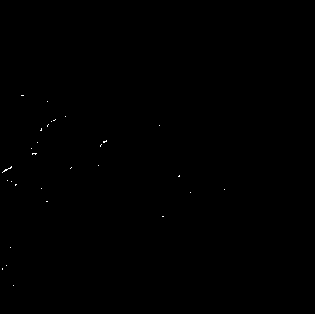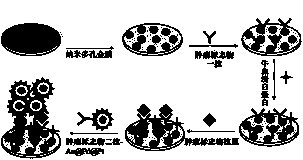Preparation and application of tumor marker immunosensor built by putamen nanometer materials
A tumor marker and immunosensor technology, applied in the field of new nano functional materials and biosensing, can solve the problems of unreproducible sample luminescence and poor stability, and achieve the effect of batch sample determination, improved performance and high catalytic performance.
- Summary
- Abstract
- Description
- Claims
- Application Information
AI Technical Summary
Problems solved by technology
Method used
Image
Examples
Embodiment 1
[0057] The preparation of a tumor marker immunosensor constructed of shell-core nanomaterials comprises the following steps.
[0058] (1) Float the silver-gold alloy film in 15 mol L -1 On the surface of the nitric acid solution for 0.5 min, the silver was etched away with concentrated nitric acid to form a nanoporous gold film. The nanoporous gold membrane was washed with ultrapure water until its pH = 7.0.
[0059] (2) Add 20 mmol·L to the flask -1 Chlorauric acid 2.5 mL; 20 mmol L -1 Sodium tetrachloropalladate 4.0 mL; 20 mmol L -1 Potassium tetrachloroplatinate 4.0 mL; block polyether F-127 0.1 g, mix well and add 0.4 mol·L -1 Ascorbic acid 1.0 mL. Stir at room temperature for 1 h. Centrifuged and washed 3 times with water, AuPdPt core-shell nanomaterials were made after drying. The morphology of the nanomaterials is shown in figure 1 ,Depend on figure 1 It can be seen from the transmission electron microscope that AuPdPt has a shell-core structure with a particl...
Embodiment 2
[0064] The preparation of a tumor marker immunosensor constructed of shell-core nanomaterials comprises the following steps.
[0065] (1) Float the silver-gold alloy film in 15 mol L -1 On the surface of the nitric acid solution for 3 min, the silver was etched away with concentrated nitric acid to form a nanoporous gold film. The nanoporous gold membrane was washed with ultrapure water until its pH = 7.0.
[0066] (2) Add 20 mmol·L to the flask -1 Chlorauric acid 2.5 mL; 20 mmol L -1 Sodium tetrachloropalladate 4.0 mL; 20 mmol L -1 Potassium tetrachloroplatinate 4.0 mL; block polyether F-127 0.1 g, mix well and add 0.4 mol·L -1 Ascorbic acid 1.0 mL. Stir at room temperature for 1 h. Centrifugal washing 3 times, after drying, the AuPdPt core-shell nanomaterials were made, and the TEM morphology was shown in figure 1 .
[0067] (3) Mix AuPdPt core-shell nanomaterials and tumor marker secondary antibodies into pH = 7.4 phosphate buffer solution to make a mixed solution,...
Embodiment 3
[0071] The preparation of a tumor marker immunosensor constructed of shell-core nanomaterials comprises the following steps.
[0072] (1) Float the silver-gold alloy film in 15 mol L -1 On the surface of the nitric acid solution for 5 min, the silver was etched away with concentrated nitric acid to form a nanoporous gold film. The nanoporous gold membrane was washed with ultrapure water until its pH = 7.0.
[0073] (2) Add 20 mmol·L to the flask -1 Chlorauric acid 2.5 mL; 20 mmol L -1 Sodium tetrachloropalladate 4.0 mL; 20 mmol L -1 Potassium tetrachloroplatinate 4.0 mL; block polyether F-127 0.1 g, mix well and add 0.4 mol·L -1 Ascorbic acid 1.0 mL. Stir at room temperature for 1 h. Centrifugal washing 3 times, after drying, the AuPdPt core-shell nanomaterials were made, and the TEM morphology was shown in figure 1 .
[0074] (3) Mix AuPdPt core-shell nanomaterials and tumor marker secondary antibodies into pH = 7.4 phosphate buffer solution to make a mixed solution,...
PUM
| Property | Measurement | Unit |
|---|---|---|
| recovery rate | aaaaa | aaaaa |
Abstract
Description
Claims
Application Information
 Login to View More
Login to View More - R&D
- Intellectual Property
- Life Sciences
- Materials
- Tech Scout
- Unparalleled Data Quality
- Higher Quality Content
- 60% Fewer Hallucinations
Browse by: Latest US Patents, China's latest patents, Technical Efficacy Thesaurus, Application Domain, Technology Topic, Popular Technical Reports.
© 2025 PatSnap. All rights reserved.Legal|Privacy policy|Modern Slavery Act Transparency Statement|Sitemap|About US| Contact US: help@patsnap.com



